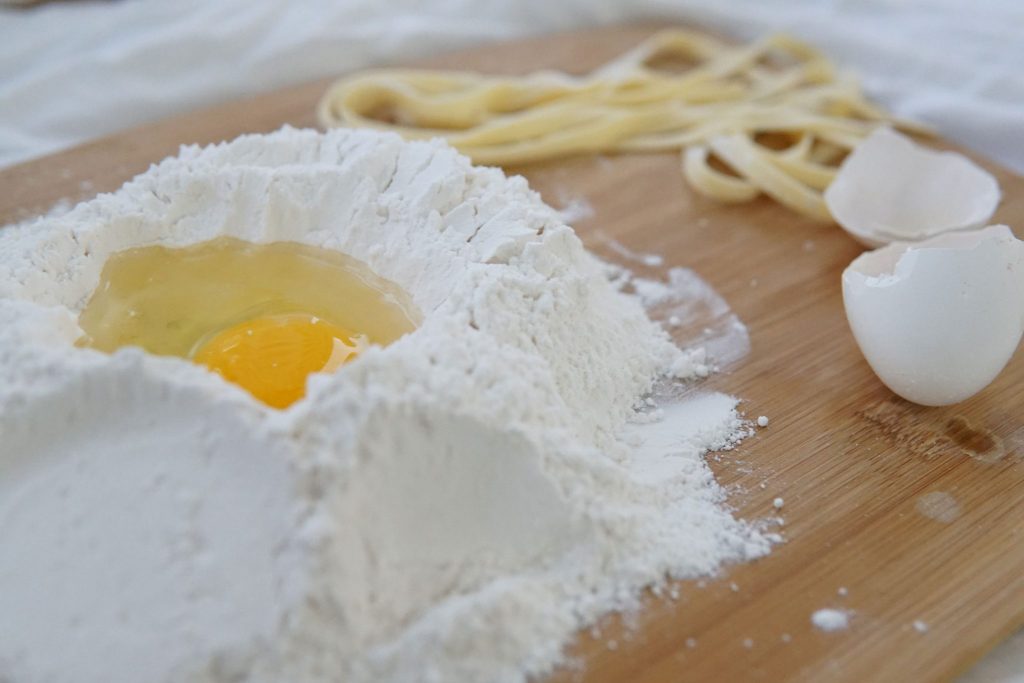The day the category manager turned the brand into a commodity
One of the top three things we get told at Pricing Insight by clients and prospects is that their products have become “commodities.” Here’s a story of a category manager presentation that really brings home how easy it is to get caught implementing suboptimal prices into your business.
It’s a story of being tied down to self-limiting beliefs, setting prices based on competitors, or using units of measure price comparisons (such as dollars per kilo, or price per sheet in this example).
The Fixed Pie Mindset
To set the scene: A company was holding a bi-annual category price review session. The meeting got underway with the commercial, category and sales teams present. The category manager for the Pampas brand had the PowerPoint slide up on the screen.
The title on the slide said “Value Ladder”. If only it was. He advised us that “since the Pampas price per sheet was 1.71x the brand Borg’s product and 2.18x the Home brand product, there was zero chance a price increase could or should occur”.
Did that logic seem right?
It was factual enough, but was it really true?
Is that all that was needed to establish the “value ladder”?
Simply dividing the retail price by the number of pieces in the packet? It didn’t feel right.
What he had done was to make a Unit of Measure (UoM) comparison between the products to then determine the so-called value–and hence the pricing power available to the Pampas brand. This sounds and looks like pure commoditisation by the brand / category manager. Normally that honour goes to the sales team.
However, let’s fast-forward to the present, and look at what has actually occurred with the “Value Ladder”. The Pampas brand is now 1.8x the branded Borg product and 2.4x the Home brand product.
Wow: substantial price premiums and an everyday pricing unicorn.
The key to note here is not the absolute percentages or even the price relativities. The key is the underlying assumption about what constitutes value.
In Australia, unit of measure pricing tickets adorn supermarket shelves to help customers do the math on the price per kilo of food they are buying. But there’s no mention of value. However, you can build an eight-lane-wide freeway between the Pampas brand and the Borg or Home brand products based on simple UoM comparisons.
Something else is holding up the price; it’s not enough to say that the brand has pricing power. Brands amplify the inherent characteristics underlying purchase drivers—or the psychological, emotional, or physical “want states” of the customer.
A brand does not stand in isolation because of the nice packaging design, logo or tag line. A great brand will dance with the pricing strategy in a “value tango” where each one will take the lead at some point but both support each other all the way.
Behold the Chicken Pot Pie
To understand the dynamics of what could be supporting the price premium for Pampas, we need to understand why on earth you might want to buy sheet pastry in the first place. The answer is below.
Yes, behold, it is a chicken pot pie. Delicious.
It is probably not going to be on the work cafeteria menu today, but you could make one at home. We have included the recipe at the end of this post. We’ll be available the day that you decide to make it.
Pie-Making by the Numbers
We have some interesting statistics to share on the purchase of puff pastry. These relate to Australia, but are likely similar across other pie-eating nations.
In the world of supermarket products, there are over 100 ways you can analyse a product’s sales history performance to make it show what you want to see or tell the story you want to tell. There are, however, some hard facts that can be really useful when thinking about the product’s pricing power and value to the customer:
% of users against total market size – penetration rate or who is using the product
The first of these is the household penetration rate. This refers to the number of households that actually buy the product. In the case of Pampas, this number is around 11%, or roughly 1 in 10 households. That group is niche enough to warrant some pricing opportunity analysis–however, this is where it gets interesting.
Inter-purchase interval / frequency
Of those people who buy the product, around 70% of them buy it just once per year. What does that signal to you? How do you classify things that you do just once per year? Everyday routine or special occasion?
Yes, this purchase is probably for a special occasion. If you’re making a family-sized chicken pot pie, you are likely making it for loved ones. Now, if you are having family or friends over for this special event that is occurring once per year, what is going through your mind? Do you want your pie to be:
- just ok?
- good?
- amazing?
Yes, the answer is c. If you answered in the affirmative to either of the first two options, you don’t cook or have no love in your heart—or both.
For the accountants and economists reading this article, let’s look at the complementary products needed to make a chicken pot pie. You may want to refer to the recipe below. There is most likely about $20 worth of direct materials. But by far the biggest “cost” is the direct labour. There are about 12 significant steps required in the recipe below and most likely an hour of recipe-making labour. Let’s also estimate another hour of associated shopping and clean-up of the kitchen time. Let’s cost that labour at minimum wage rate of $18.29 per hour. So, total labour of $36.58.
Add the materials and labour together and throw in some allocated overhead of, say, $5. We get a total investment of:
- Direct Materials = $20.00
- Direct labour = $36.58
- Overhead = $5.00
- Total Pie costs = $61.58
So, one could argue that the price of the pastry per sheet is minor or insignificant when compared with the total delivered cost. That would be enough to justify testing higher price points. However, this thinking would miss the most crucial part of the whole value equation.
The Crucial Element of Value
Most people buy puff pastry once per year. This is one of the most important meals they will make over the next 12 months. Is now the time to start thinking about saving $0.40 – $0.50 cents on a sheet of pastry, when your total economic investment is 67x the pastry cost? 50% of consumers say no, and buy the product with the price premium.
Effectively, the price premium is a “put option” or mitigation strategy for the risk associated with the event that is the Chicken Pot Pie Extravaganza. People will pay premiums to mitigate risk or avoid pain. Neuroscientists and authors like Nobel prize-winning researcher Daniel Kahneman have proven this in books like “Thinking Fast and Slow”. In this case, the pastry is the highest-profile ingredient. It is the first thing people will see and is a primary driver of taste for the pie. You want to make sure that the pie will be amazing for this one-off event, so you are now exposed to several forms of pain or risk:
- Economic pain – you have spent a lot of money and time
- Psychological pain – this is your moment to shine in the kitchen no one wants to fail at making this trophy meal
- Social pain – you want your guests / family and friends to congratulate you on a pie well done, not sit silently after the meal and awkwardly say “that was nice…thank you”. Which is what you would probably say after having your first meet-the-parents-in-law dinner where they served you chicken livers and lamb’s brains.
So, if we added the economic costs of $61.58 we would still need to add in the potential emotional costs of getting your chicken pot pie wrong, or covering it with inferior pastry. This is where we will struggle to put a dollar figure on this element of value–but you could try for a proxy model of compensation.
In other words, describe the emotional costs according to how much you would need to be paid to live down your failed chicken pot pie experiment. Imagine the stories that would be told for years to come reminding you of the kitchen nightmare that you brought on yourself. Sends shivers down the spine just thinking about it.
The compensation for this emotional pain could run into the hundreds if not thousands of dollars, depending on the situation. Now, the $0.50 per sheet premium seems to be a bargain compared to the totality of the value in play.
So, this is a case study about pastry pies.
I sell steel, timber, software or a service. How do I relate to it?
Is this case example only relevant if you are making a pie or related supermarket products? You should be able to see some parallels with your own industry. What’s required to make great pricing decision is translation or inferential observation.
In other words, does the pricing principle translate to other industries? Consider using the following three methods to make better price setting decisions:
- Economic + Emotional Value Estimation: Many pricing practitioners know well the concept of economic value estimation from a hard dollars and cents perspective. We believe the emotional value of risk and the pain of failure has more pricing power by a factor of 200-1000% vs. logical dry economic arguments.
- Case precedent (from the legal profession): This is where you ask: Has this pricing scenario has happened before in neighbouring products / services or industries?
- Hypothesis-led pricing processes (scientific method): If we assume X & Y, will Z be the result? A/B/C tests also work well: A = control group (no change / business as usual), B = minor changes to make modest but low-risk gains C = Revolutionary or radical changes to the pricing or revenue model. Test out each idea in a low-risk way until you find a breakthrough.
Some Questions to Ask When Setting Prices for Products or Services:
- What is the application of this product or service?
- What is the motivation to buy?
- Who is the economic buyer and final consumer?
- What is the purchase frequency or inter-purchase interval?
- What are the economic, emotional and social consequences for the buyer if the product was not fit for purpose or failed in use?
Some Caveats
- Units of measure are not very effective ways to identify price premiums and margin opportunities.
- Competitor price points are often dead ends or circular reference logic loops: You’re watching them watching you watching them watching you.
- Costs are 100% irrelevant to the price setting process and 100% relevant for the decision to enter a market: Two very different rivers of logic that need to meet somewhere.
If your team believe in some way that what they are just selling is a commodity, then your biggest competitive threat is your own team. The antidote to this is to build a belief system around value that is sustainable and–like the best brands–amplifies what is inherent about the product or service beyond simplistic feature comparisons with competitors or what appear to be physical alternatives.
Are they emotional alternatives? In many cases they are not. There is pricing power in this line of thinking.
Epilogue
After working with over 100 companies in the last 10 years, and 20 years in pricing strategy, we can say that the biggest margin pressure in your business comes from the staff who believe that what they sell is a commodity. In other words, internal perception drives down margins faster and harder than any real external threat.
Chicken Pot Pie
Now to the business end of this paper: The recipe for chicken pot pie. Note that if you do decide to make it, please feel free to send an invite, We will be available that day.
- Tablespoons butter
- 1 onion, chopped
- 2 carrots, chopped
- 2 cloves garlic, minced
- 2 cups stemmed and quartered white or cremini mushrooms
- 2 cups frozen pearl onions
- 2 cups chopped, cooked chicken
- 1/4 cup flour
- 2 cups low-sodium chicken broth, warmed
- 1 cup 2 percent or whole milk – 1/2 cup half-and-half
- 1 1/2 cups frozen peas
- salt and pepper to taste
- 1 sheet puff pastry, defrosted
- 2 egg whites, lightly beaten
Steps
Heat butter in large saute pan or pot over medium heat.
When it’s melted, add onion, carrots and garlic and cook until onion is translucent and carrots begin to soften, 5 minutes.
Add mushrooms and pearl onions and cook, stirring occasionally, for another five minutes.
Stir in chicken and flour, using a wooden spoon to ensure vegetables and meat are evenly coated with flour.
Slowly pour in chicken broth, using a whisk to beat it in to help avoid clumping of the flour (having broth warm helps smooth out the surface).
Once the broth is incorporated, add the milk and half-and-half and simmer 10-15 minutes, until sauce has thickened substantially and lightly clings to the veggies and chicken.
Stir in peas. Season with salt and pepper.
Preheat oven to 375 degrees.
Cut pastry into quarters. Roll out each piece on a floured surface to make a 6” square.
Divide chicken mixture among 4 ovenproof bowls.
Place a pastry square over the top of each bowl and trim away excess with a paring knife; pinch the dough around the edges of the bowl to secure it.
Brush tops with the egg whites and bake until golden brown, about 25 minutes.
Click here to download the whitepaper.






